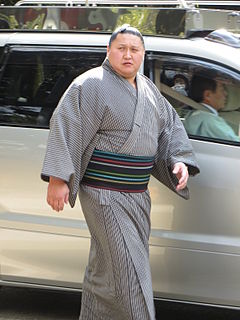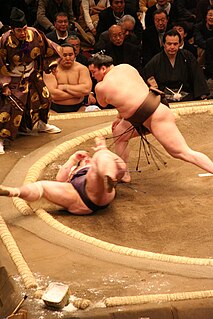
A rikishi (力士) sumotori or, more colloquially, sumosan, is a professional sumo wrestler. Rikishi are expected to live according to centuries-old rules and, although there are some exceptions, most come from Japan, where sumo is practiced exclusively. Participation in official tournaments is the only means of marking achievement in sumo and the rank of an individual rikishi is based solely on official wins.

Konishiki Yasokichi is a Hawaiian-born Japanese-Samoan former sumo wrestler. He was the first non-Japanese-born wrestler to reach ōzeki, the second-highest rank in the sport. During his career he won the top division championship on three occasions and came close to becoming the first foreign-born grand champion, or yokozuna, prompting a debate as to whether a foreigner could have the necessary cultural understanding to be acceptable in sumo's ultimate rank. At a peak weight of 287 kg (633 lb) he was also the heaviest wrestler ever in sumo, earning him the nicknames "Meat Bomb" and "Dump Truck".

Toshimitsu Obata known as Kitanoumi Toshimitsu (北の湖敏満), was a sumo wrestler. He was the dominant yokozuna in sumo during the 1970s. Kitanoumi was promoted to yokozuna at the age 21, becoming the youngest ever to achieve sumo's top rank, and he remained a yokozuna for a record 63 tournaments. He won 24 tournament championships during his career and was one of a series of truly great yokozuna who came from Hokkaidō, the northernmost main island of Japan. At the time of his death he still held the record for most bouts won as a yokozuna (670). Following his retirement in 1985 he established the Kitanoumi stable. He was chairman of the Japan Sumo Association from 2002 until 2008, and from 2012 until his death.
Takamiyama Daigorō is a former sumo wrestler, the first foreign-born wrestler to win the top division championship. His highest rank was sekiwake. His active career spanned twenty years from 1964 to 1984, and he set a number of longevity records, including most tournaments ranked in the top makuuchi division, and most consecutive top division appearances. He is also the first foreign-born wrestler ever to take charge of a training stable, founding Azumazeki stable in 1986. His most successful wrestler was fellow Hawaiian Akebono who reached the highest rank of yokozuna in 1993. He retired as a coach in 2009.

Kyokutenhō Masaru in Nalaikh, Ulan Bator, Mongolia is a former professional sumo wrestler. He made his debut in March 1992 out of Ōshima stable, with the first group of Mongolians ever to join the sport in Japan, reaching the top makuuchi division in January 1998. In his exceptionally long career he received seven special prizes for Fighting Spirit, and won one yūshō, in May 2012 from the maegashira ranks, which made him at 37 the oldest first–time yūshō winner in sumo history, and he was runner-up in one other tournament. His highest rank was sekiwake, which he held on three occasions. He was the first wrestler since the 1950s to be ranked in the top division after the age of 40. He made more appearances in the top division than any other wrestler at 1470, and only Ōshio fought more than his 1870 career bouts. He announced his retirement in July 2015 and declared his intention to stay in sumo as an elder, having acquired Japanese citizenship in 2005. In 2017 he became the head coach of Tomozuna stable and he is known as Tomozuna-oyakata.

Kaiō Hiroyuki is a former professional sumo wrestler from Nōgata, Fukuoka, Japan.
Takeshi Inoue, known by his stage name Takeshi Rikiō, born December 20, 1972, is a Japanese retired professional wrestler, who worked for Pro Wrestling Noah. He is also a former sumo wrestler.

Ōnokuni Yasushi is a former sumo wrestler from Hokkaidō, Japan. Making his professional debut in 1978, he reached the top division in 1983. In 1987 he won his first yūshō or tournament championship with a perfect score and became the sport's 62nd yokozuna. However, he was able to win only one more championship before his retirement in 1991. He has remained in sumo as a coach and in 1999 became the head of Shibatayama stable. He was elected to the Japan Sumo Association's board of directors in 2018. His peak weight was 210 kg (463 lbs) in May 1989.

Hokutoumi Nobuyoshi is a former sumo wrestler from Hokkaidō, Japan. He is the sport's 61st yokozuna and won eight top division championships. He wrestled for Kokonoe stable, as did yokozuna Chiyonofuji, and the two were the first yokozuna stablemates to take part in a play-off for the championship, in 1989. After a number of injury problems he retired in 1992, and is now the head coach of Hakkaku stable. In November 2015 he was appointed the chairman of the Japan Sumo Association, following the death of Kitanoumi, initially to serve until the end of March 2016. He was then elected as head for a full term by his fellow board members in a vote held on March 28, 2016, and re-elected in 2018.

Aminishiki Ryūji is a Japanese sumo wrestler. He made his professional debut in 1997 and reached the top makuuchi division in 2000. He has earned twelve special prizes and won eight kinboshi or gold stars for defeating yokozuna during his career, the most amongst active wrestlers. He has twice been runner-up in a tournament. The highest rank he has reached is sekiwake. He is in the all-time top ten for a number of sumo records, including most top division wins, most top division appearances and most tournaments ranked in the top division. He wrestles for Isegahama stable.

Harumafuji Kōhei, previously known as Ama Kōhei, is a retired sumo wrestler. He received his promotion to yokozuna, sumo's highest rank, on September 26, 2012. He is the third Mongolian and fifth overall non-Japanese wrestler to attain yokozuna status.
Professional sumo is divided into six ranked divisions. Wrestlers are promoted and demoted within and between these divisions based on the merit of their win/loss records in official tournaments. For more information see kachi-koshi and make-koshi. Wrestlers are also ranked within each division. The higher a wrestler's rank within a division is, the stronger the general level of opponents he will have to face becomes. According to tradition, each rank is further subdivided into East and West, with East being slightly more prestigious, and ranked slightly higher than its West counterpart. The divisions, ranked in order of hierarchy from highest to lowest, are as follows:

Tochinowaka Kiyotaka is a former sumo wrestler from Wakayama Prefecture, Japan. A former amateur champion, he turned professional in 1985, reaching the top makuuchi division in 1987. His highest rank was sekiwake. He was a runner-up in one tournament and earned six special prizes and four kinboshi. After 76 tournaments and 1114 bouts in the top division he retired in 1999. He is now an elder of the Japan Sumo Association and the head coach of Kasugano stable.

Musashimaru Kōyō is a former sumo wrestler. He made his professional debut in 1989, and reached the top makuuchi division in 1991. After reaching ozeki rank in 1994 his progress seemed to stall, but in 1999 he became the second foreign-born wrestler in history to reach the rank of yokozuna. He won over 700 top division bouts and took twelve top division tournament championships during his career. Musashimaru's sheer 235 kg (518 lb) bulk combined with 1.92 m of height made him a formidable opponent, and he was remarkably consistent and injury-free for most of his career. An amiable personality, his fan base was helped by a surprising facial resemblance to Japanese warrior hero Saigō Takamori. After retiring in 2003, he became an elder of the Japan Sumo Association and founded the Musashigawa stable in 2013.

Sōkokurai Eikichi is a professional sumo wrestler from Inner Mongolia, China. He is the only Chinese national to reach the top makuuchi division. Sōkokurai is of Mongolian descent. He made his professional debut in 2003 and was promoted to the top division in September, 2010. In April 2011 he was ordered to retire by the Japan Sumo Association after being found guilty of involvement in match-fixing. Refusing to do so, he was dismissed. However, in March 2013 his dismissal was nullified by the Tokyo District Court and after the Sumo Association decided not to appeal the decision he reappeared on the banzuke in July 2013 at the Nagoya Basho, ranked as a maegashira 15, the rank he was at when he was expelled. His highest rank to date of maegashira 2 was achieved in March 2017. He has won one special prize for Technique and one gold star for beating a yokozuna.

Gagamaru Masaru is a professional sumo wrestler from Georgia. The third Georgian national after Kokkai and Tochinoshin to make the top makuuchi division, he made his professional debut in November 2005, reaching the jūryō division in November 2009 and makuuchi in July 2010. Originally from Kise stable, he briefly competed for the Kitanoumi stable before moving back to the Kise stable after it was re-established. His highest rank has been komusubi. He has won two special prizes for Fighting Spirit and has been runner-up in one tournament.
Wakamiyama Kōhei is a former sumo wrestler from Toyama City, Japan. He made his professional debut in November 1957, and reached the top division in January 1964. His highest rank was sekiwake. He retired in November 1969.
Kōhei, Kohei or Kouhei is a masculine Japanese given name. Notable people with the name include:
















